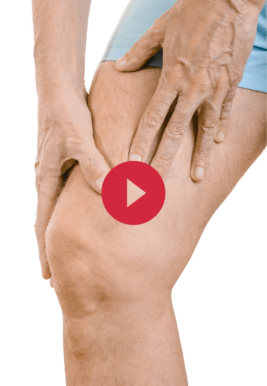Patellofemoral Pain Syndrome | Diagnosis & Treatment for Physios

Patellofemoral Pain Syndrome | Diagnosis & Treatment for Physios
Patellofemoral Pain Syndrome (PFPS) typically refers to anterior knee pain usually occurring during activities such as running, squatting, or walking up and downstairs. It should be seen as a diagnosis of exclusion though, meaning that the diagnosis is formed once all other possible conditions have been excluded such as meniscus, ligamentous or intra-articular pathologies (Crossley et al. 2016).
One hypothesis is abnormal patellofemoral joint alignment and morphology of the trochlear groove. Consequently, the patella can’t track smoothly up and down, which over time can cause irritation of the joint surfaces and triggers nociception (Crossley et al. 2016).
Secondly, muscle weakness of the quadriceps (Lankhorst et al. 2012) and glutes (Rathleff et al. 2014) have been considered potential risk factors associated with PFPS. Patients with PFPS showed 6-12 % less strength than their healthy controls. It is assumed that poor strength and function in the quadriceps will influence how the patella tracks in the trochlea and how the load is distributed across the patellofemoral joint (Willy et al. 2016).
Weak glutes on the other hand can alter the leg axis if the femur adopts a more internally rotated position with regards to the tibia again impairing smooth movement of the patella within the femoral trochlea (Willson et al. 2008, Powers 2010).
The biomechanics of PFPS have been challenged though. A systematic review of prospective predictors by Pappas et al (2012) found no significant link in many of the proposed anthropometric variables. Furthermore, Noehren (2007) found no difference in femoral internal rotation in a prospective cohort of runners who went on to develop PFPS compared to those who did not.
So while the biomechanical link may not be so clear, the above coupled with a drastic increase in load (intensity, frequency, duration) may eventually lead to symptoms.
Epidemiology
Anterior knee pain is one of the most commonly encountered problems in the primary care setting. However, no reports on the true incidence of PFPS amongst this population exist to this day (Rothermich et al. 2015). In young adolescents, studies have shown a prevalence ranging between 7-28% and an incidence of 9.2% (Rathleff et al. 2015, Hall et al. 2015). Studies on PFPS in military personnel reported an annual incidence of 3,8% in men and 6,5% in female recruits, with a prevalence of 12% in men and 15% in women (Boling et al. 2010). Typically seen in practice is a young female patient who engages in running (Glaviano et al. 2015, Smith et al. 2018).
Follow a course
- Learn from wherever, whenever, and at your own pace
- Interactive online courses from an award-winning team
- CEU/CPD accreditation in the Netherlands, Belgium, US & UK
Clinical Picture & Examination
As stated in the introduction, patients with PFPS will usually describe dull/achy pain around or behind the patella, which is aggravated by at least one weight-bearing activity such as squatting, stair ambulation, jogging/running, hopping, or jumping.
Additional, but not necessarily required are:
- Crepitus or grinding sensation from the patellofemoral joint during knee flexion movements
- Tenderness on patellar facet palpation
- Small effusion
- Pain on sitting, rising on sitting, or straightening the knee following sitting
Physical Examination
While Cook et al. (2010) describe three test clusters for PFPS, they have little diagnostic value.
These are:
- Retropatellar pain during resisted quadriceps contraction + Pain during squatting
- Retropatellar pain during resisted quadriceps contraction+ Pain during squatting + Pain during peripatellar palpation
- Retropatellar pain during resisted quadriceps contraction+ Pain during squatting + Pain during kneeling
Essentially, asking a patient whether they have anterior knee pain while squatting is the best available test to date, as PFPS will be evident in 80% of people with this finding. But PFPS has to be seen as a diagnosis of exclusion meaning the diagnosis is formed after all other possible pathologies have been excluded.
One orthopedic test that can be useful as it replicates the typical pain described during 30-60° of flexion is the decline step-down test:
To conduct the test, you will need two steppers or alternatively conduct the test on a treadmill that has an inclination feature. One step is placed on the other at an angle of 20°. You can assess this angle using your smartphone inclinometer. The lower end of the stepper was 20cm high.
The patient stands on the affected leg on the stepper so that the toes are at the lower end of the stepper. They keep the ipsilateral hand over the greater trochanter and can touch the wall with one fingertip for movement control and to prevent fear.
Then the patient is asked to simulate descending stairs by stepping down and forward with the contralateral leg which induced knee flexion at the affected knee. This should only be done in the pain-free flexion range. Instruct the patient to keep the knee in line with the foot to prevent excessive knee valgus.
A study by Selfe et al. in (2000) reported a critical angle of 61.3° during the test for healthy subjects before they lost control during the step-down. This could be used as a reference to evaluate your treatment effects with this test. Alternatively, as with other lower limb performance tests, you could use a limb symmetry index between the affected and non-affected knee.
Other orthopedic tests to assess patellofemoral pain are:
THE ROLE OF THE VMO & QUADS IN PFP

Follow a course
- Learn from wherever, whenever, and at your own pace
- Interactive online courses from an award-winning team
- CEU/CPD accreditation in the Netherlands, Belgium, US & UK
Treatment
Several treatment approaches have been proposed for the management of PFPS. The 2018 consensus statement again states that exercise therapy is the treatment of choice (Collins et al. 2018). Uncertainty remains around adjunct therapies such as acupuncture or manual soft tissue therapies. In the early to intermediate term, patellar taping may allow the patient to perform strengthening exercises pain-free though the mechanism through which pain inhibition occurs is rather non-biomechanical (Barton et al (2015).
Here are two different taping techniques that might help your patient to relieve pain on short-term:
We have since filmed three different proposed exercise programs that target the hip, knee, or a combination of the two. Choosing which exercises to incorporate remains subjective and should be tailored to the patient’s demands and needs. Starting with the activity or movement that causes pain, try to modify it and see if it influences the knee pain and incorporate proximal muscle strengthening (Lack et al. 2015).
Treatment of PFPS has to be seen as multimodal and this is supported most consistently by multiple high-quality reviews. Barton et al. (2015) emphasize that a combination of education, and active over passive interventions showed the most consistent short and long-term results. Education plays a key role in the treatment of the condition. Recommendations are:
Ensure the patient understands potential contributing factors to their condition and treatment optionsAdvise of appropriate activity modificationManage the patient’s expectations regarding rehabilitationEncourage and emphasize the importance of participation in active rehabilitationAs with all overuse injuries, load management in a biopsychosocial framework is key to rehab success. So while you may address strength deficits with a targeted exercise program, improve running mechanics, and reduce other factors such as high levels of stress, poor sleep quality, fear-avoidance beliefs, or thoughts that pain equals damage should not be forgotten as they play a key role in the pain experience.
References
Follow a course
- Learn from wherever, whenever, and at your own pace
- Interactive online courses from an award-winning team
- CEU/CPD accreditation in the Netherlands, Belgium, US & UK
Increase Your Treatment Success in Patients with Knee Pain


What customers have to say about this online course
- Esra06/02/25Leuk en nuttig! Leuke cursus. Leuke afwisseling tussen tekst, video en toetsjes. Prettig dat de tekst in het Nederlands was.Linda Valk01/01/25Pfp syndroom cursus Hele fijne cursus, met duidelijke uitleg, zowel theoretisch als praktisch duidelijk.
- Erik Plandsoen31/12/24PFP & Hoffa fat pad syndrome Hele fijne cursus, met duidelijke uitleg, zowel theoretisch als praktisch duidelijke oefeningen.Anneleen Peeters22/12/24Great! Super interesting and insightful. Definitely a great tool to freshen up and expand on previous knowledge.
- Ronald Dols13/12/24Top cursus Mooie holistische benadering van een veelvoorkomend probleem.Olivier21/11/24Goede cursus! Hele goede cursus!
- Berfin Karagecili03/09/24Patellafemoraal pijn en fat pad syndroom Patellafemoraal pijn en fat pad syndroom
Hele duidelijke uitleg met instructie video’s. de tussentijdse toetsen waren ook handig om zo 100% uit je stof te kunnen halen.Martijn de Bruijn24/05/24PATELLOFEMORAL PAIN & FAT PAD SYNDROME It was a great course by Claire!! Nice explanation of the examination and treatment modalities.
Also the sport specific parts were very helpful. - Jean-Christophe Di Ruggerio04/03/24PATELLOFEMORAL PAIN & FAT PAD SYNDROME Great course with a knee expert!Seppe van den Audenaerde09/12/23PATELLOFEMORAL PAIN & FAT PAD SYNDROME GREAT COURSE THAT OPENED MY VIEW ON KNEE PAIN
Because of the way Claire looks at the knee joint and its surrounding joints, I learned a lot and it opened my eyes. Will look into her other courses for sure! - Alvin Chi24/07/23PATELLOFEMORAL PAIN & FAT PAD SYNDROME BEST PFPS RESOURCE I HAVE FOUND
I cannot recommend this course enough. I stumbled upon this course through the physiotutors podcast, and Claire’s episode on there intrigued me enough to purchase the course. As someone who treats PFPS every day, I have yet to find a resource that tries to personalize treatment for the patient rather than broadly treating all patients the same. Claire goes into detail on how physical exam findings lead to different treatment options. I wish this course was available 10 years ago. I highly recommend this course and hope Claire continues to contribute more courses on physiotutors!Cesare Cambi15/06/23PATELLOFEMORAL PAIN & FAT PAD SYNDROME COURSE ABSOLUTE AMAZING
The course has given me a very deep and practical insight over the PFPS’ patients. it was full of nice and important clinical and practical tips for everyday usage, thing that I really enjoyed and appreciated
I personally liked the most the sections regarding the assessment strategies and the brace and taping’s techniques, but overall a must-do course on for anyone interested in improving his/her skills in the treatment of Knee pain. - Lorna Thornton-McCullagh14/06/23PATELLOFEMORAL PAIN & FAT PAD SYNDROME THANK GOODNESS FOR CLAIRE PATELLA
What a brilliant course. A colleague had attended her course and recommended it to me- I never fancied attending London so when it came on line I grabbed the opportunity. Claire P always presents complicated material clearly and thoroughly without the normal physiotherapist pomp and circumstance. This course has been well researched with up to date evidence and well conveyed- THANK GOODNESS FOR CLAIRE PATELLAGeorge Hill12/05/23PATELLOFEMORAL PAIN & FAT PAD SYNDROME Excellent course by Claire Robertson, I thoroughly enjoyed it. Learned so much!. Well done physiotutors, keep up the great work you guys are doing. - Hannah Toppets06/12/22PATELLOFEMORAL PAIN & FAT PAD SYNDROME PFP & FAT PAD SYNDROME
Great course with nice video’s and clear info on the objects. Also nice to have a little quiz after each chapter. Nice to know how to tape and sport-specific rehab.



